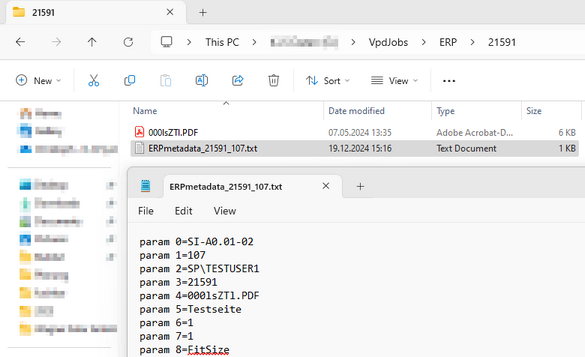(Last update of this topic: 05-13-2025)
To process the print job via steadyPRINT, the ERP system must basically create a job folder and store the actual job file as well as a file with job information there.
For processing the print job via steadyPRINT, the following procedure is required:
| 1. | The ERP system creates a clear job folder with a sequential number (spool ID) in the VPD print job directory. |
| 2. | The ERP system stores a job file (PDF, PCL, PS) in the previously created job folder in the VPD print job directory. |
| 3. | The ERP system creates a META file in UTF8 format including job information. |
| 4. | The ERP system stores the META file created under point 3 including the job information in the job folder created under point 1 (ERPmetadata_[Spool-ID]_[PrintServer-ID].txt) in the VPD print job directory. |
A completely created job folder in the VPD print job directory with all relevant files and job information could look like figure ERP - Example job folder:

Figure 72: ERP - Example job folder
Structure and content META file (ERPmetadata_[Spool-ID]_[PrintServer-ID].txt)
param 0: Target printer
param 1: Print server-ID from steadyPRINT database (table dbo.PrintServers)
param 2: Windows user from Active Directory
param 3: Spool-ID
param 4: Job file name
param 5: Job display name
param 6: CopyCount (optional)
param 7: PageCount (optional)
param 8: PageScalingMode (optional)
Note |
META file |
|
The META file must be stored in UTF-8 format. Furthermore, the parameter names of sequence and naming must be considered. Optional parameters may be omitted or filled with empty values. |
Explanation to parameter META file
| • | Target printer (param 0): Indicates the name of the target printer on the print server. The printer must exist with the name on the print server. |
| • | Print server-ID (param 1): Indicates the clear print server number from the table dbo.PrintServers within the steadyPRINT database. |
| • | Windows user (param 2): Indicates a Windows user (format: Domain\Login name; Example: SP\TESTUSER1), to whom the print job is to be assigned to within steadyPRINT. |
| • | Spool ID (param 3): Clear number which can be used as a cross-system spool ID. This could be a timestamp as ticks, for example (see https://learn.microsoft.com/de-de/dotnet/api/system.datetime.ticks?view=net-9.0). |
| • | Job file name (param 4): Indicates the name of the job file which is to be sent to the printer. This must exist in the job folder in the VPD print job directory. |
| • | Job display name (param 5): Indicates the display name of the print job. |
| • | CopyCount (param 6): Indicates the optional number of copies for the print job. |
| • | PageCount (param 7): Indicates the optional page count for the print job. |
| • | PageScalingMode (param 8): Indicates the optional page scaling. The following values are available: FitSize (adaptive content size), ActualSize (actual content size), ShrinkOversized (shrink oversized pages), CustomScale (custom scaling). Default: FitSize.. |